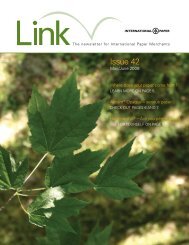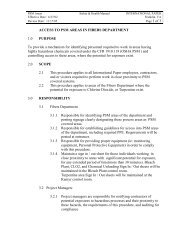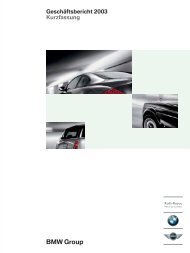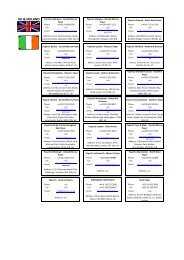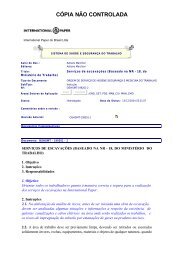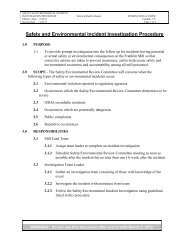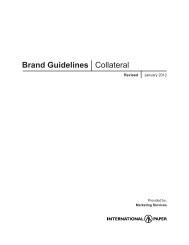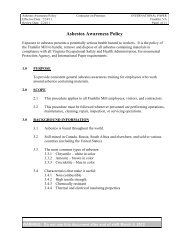Safety Information 2012 - International Paper
Safety Information 2012 - International Paper
Safety Information 2012 - International Paper
Create successful ePaper yourself
Turn your PDF publications into a flip-book with our unique Google optimized e-Paper software.
Franklin Mill<br />
<strong>Safety</strong> <strong>Information</strong> <strong>2012</strong><br />
1. <strong>Safety</strong> is the #1 priority for <strong>International</strong> <strong>Paper</strong>.<br />
2. Emergency Alarm System- The plant siren system is tested on the first<br />
Wednesday of each month at 9:00 AM. If the emergency siren alarms IP<br />
personnel will dial 4711 to receive a recorded message at the guard house and<br />
instruct everyone on action needed. Then you will hear an “All Clear” message<br />
from the speakers. If you hear the “ siren and evacuate message”; conduct<br />
emergency shutdown of your operations and evacuate immediately. Assemble in<br />
the designated areas in the main parking lot. You will hear an “All Clear”<br />
message from the speakers before you can return.<br />
3. DO NOT use mill restrooms. We do not have potable water inside the mill.<br />
4. Phones in the mill do not work.<br />
5. Emergency Eye Wash and Shower stations do not work.<br />
6. Follow elevator policy. Make sure your people treat the mill elevators gently –<br />
no slamming or forcing doors; no overloading with people/materials. Materials<br />
moved in the elevators cannot extend beyond the confines of the car.<br />
7. Employees must sign in and out on the gate logs, even for fixed cost jobs.<br />
8. We only have the Main Guard House entrance open for pedestrians. Tracker<br />
trailers may get permission to enter at the back gate or at north gate by permission<br />
only. They must lock the gates back immediately after entering.<br />
9. Pedestrian walkways have been marked from the Contractor Lot to the Guard<br />
House entrance. Pedestrians have the right of way in all locations of the mill.<br />
10. <strong>Safety</strong> procedures are in the Contractor on Premises Manual located in the EHS<br />
folder on networked computers and also available over the internet at<br />
www.ipfranklinsafety.com.<br />
11. Mill emergency phone number – (757) 569-4777<br />
Southampton Hospital phone number – (757) 569-6100<br />
<strong>Safety</strong> Manger- Cabot Gavin Office- (757) 569-4090<br />
Know the STAR of Life numbers around your jobs (map & list attached)<br />
Pre-plan emergency procedures and evacuation instructions.<br />
12. If you have a total of 30 or more employees working at the mill, you are required<br />
to have a dedicated, full-time safety representative. Get the name and phone<br />
number to Cabot Gavin for IP projects (757) 569-4090 email<br />
cabot.gavin@ipaper.com and Dave Tillery for Bobwhite projects (757) 569-4105.<br />
1
13. We do not have air pressure mill wide. Mill air pressure is borderline even<br />
during normal operations.<br />
14. There will be power and water outages. Make sure you are prepared for them if<br />
they occur in your work area.<br />
15. Report any damage to mill equipment immediately. We need to get it fixed or<br />
prepare for it prior to starting the mill up.<br />
16. Mobile Equipment and Cranes/Hoists – Use trained and certified operators,<br />
even during unloading/loading of equipment by rental sub-contractors.<br />
Contractors are required to provide employee training certification for all mobile<br />
equipment. We do not have to verify the training program, but need a list of<br />
employees and equipment. Please check for obstacles and power lines, even<br />
during unloading. A ground person trained to operate a lift must be present when<br />
working on energized equipment, making a “hot tap”, or opening dangerous<br />
systems from the lift. To use IP house cranes your operator must be checked out.<br />
Contact Gary Holland at (757) 569-4194.<br />
17. Medical – Site protocol is to contact the Guard House for all emergencies. The<br />
guard will contact the IP HEAT Team and 911 Emergency Response.<br />
18. Non-English speaking employees – You must have at least 1(one) bi-lingual<br />
employee with the group at all times. Radio contact with a bi-lingual person is<br />
not adequate.<br />
19. Personal Protective Equipment – Starting a Guard House Gate –hardhat,<br />
safety glasses with side protection, safety shoes, flashlight. Wear hearing<br />
protection in noisy areas, posted or not – use the 5 feet guideline around<br />
equipment. Dark safety glasses are not permitted in any building unless for<br />
welding activity. If welding areas are inside buildings, you still need clear safety<br />
glasses for walking to and from the job site. PPE should be worn in break areas<br />
unless you have established a designated area approved by EHS.<br />
20. Heat - There are jobs that will take place in areas of high heat. Make sure you<br />
have plenty of water or sport drink available for your workers. Make sure they<br />
get enough time away from hot areas to avoid heat related problems.<br />
21. Railroads – Trains have the right of way. Do not move gates or block tracks<br />
unless cleared with your contractor manager. Use blue flags and/or derailers<br />
where required and get lockout instructions for these from your contractor<br />
manager.<br />
22. Vehicles – Trucks used to bring people to the job should discharge them at the<br />
gates and return to the contractor parking lot If it’s got a seat belt, wear it when<br />
the vehicle is in operation. Riders in the back of pickups must be seated on the<br />
2
floor, not sides, and wear PPE until out of the gate. Drivers cannot use a cell<br />
phone while driving.<br />
23. All mobile equipment must have a horn.<br />
24. Smoking – Designated Smoking Areas will be clearly marked with a sign and<br />
painted boundaries. Locations shall have a covered fire-proof container, NO trash<br />
can, one fire extinguisher, minimum of 35 feet from flammables and 5 feet from<br />
any doorway. The quickest way to lose smoking privileges is to have a lot of<br />
butts on the ground or trash other than smoking materials in the container.<br />
25. Fall Protection - Check tie-off points ahead of the job starting, and make<br />
provisions for cables, if needed. The rule says tie-off when you’re 4 feet or more<br />
above a lower elevation or working within 6 feet of a drop off such as a roof edge.<br />
However, be smart; also tie-off if there is dangerous material or equipment behind<br />
or below you. Always tie-off ladders to keep them from slipping.<br />
26. Confined Space – Work inside confined spaces requires safety harnesses and<br />
lifelines, unless specifically exempted by our procedure. Hole watch is required<br />
to wear an Orange Vest .<br />
27. Scaffolding – Must be erected by qualified people and a tag left on the<br />
scaffolding to verify that. Scaffolding must be inspected by a competent person<br />
prior to each shift’s use to make sure it’s still safe to work on.<br />
28. Barricades – Barricade areas around and below hazards your work might be<br />
creating, but barricade only the area needed to protect people. Red Danger tape<br />
barricades do not allow anyone to enter unless you are fixing the danger. Yellow<br />
Caution tape barricades allow entry after you read the sign and identify the<br />
hazards.<br />
29. Hot Work – All hot work requires a permit unless you are in a designated shop.<br />
Permits are good for one shift. All hot work requires a fire watch. Determine<br />
before the work starts how long after the hot work ends a fire watch should<br />
remain (minimum 30 minutes). Some jobs require 2 hours.<br />
30. <strong>Safety</strong> Vests – <strong>Safety</strong> vests are required for new employees for 90 days and<br />
when working in areas with frequent mobile equipment activity.<br />
31. Bay Doors - Pedestrians are not allowed to walk through mobile equipment Bay<br />
Doors. Mobile equipment is required to STOP , sound horn and proceed slowly at<br />
all Bay Doors.<br />
3
STAR OF LIFE LOCATIONS<br />
Rendezvous Location<br />
Point<br />
1 Sheet Finishing, Sheeter Room, Roll Warehouse, Trimmer Room<br />
2 Sheet Finishing, Shipping Area, Skid Shop<br />
3 Roll Finishing, New Roll Wrapper, Rewinder East Shipping Area<br />
4 Roll Finishing, South Shipping Area<br />
5 Woodyard, “A” Slasher, P&H Crane, “A” Barking Drum<br />
6 Automotive Maintenance, Roll Finishing – West Roll Storage<br />
7 Roll Finishing, North West Truck Dock, #2 <strong>Paper</strong> Machine South End<br />
8 Roll Finishing 1,2,3 Roll Wrappers, Technical Basement<br />
8-A Shipping Ramp #3 Roll Wrapper<br />
9 Technical Building, Upper Levels, Lab<br />
10 <strong>Paper</strong> Mill, Roll Grinder, #5 & #6 <strong>Paper</strong> Machine Basements<br />
11 Nos. 3,4, & 5 <strong>Paper</strong> Machine Basements, Chemical Additives<br />
12 All <strong>Paper</strong> Machines - Operating Levels<br />
13 NE Corner #6 <strong>Paper</strong> Machine, SVP Plant, Screenroom Basement<br />
14 #6 Recovery Boiler Southside (All Levels), #9 Turbine<br />
14-A Southwest Corner of “F” Bleach Line<br />
15 Pulp Mill, Reserve Tank Farm<br />
16 Pulp Mill, “G” Set Evaporators, Tall Oil Plant<br />
17 Pulp Mill Office West Side, “D” & “E” Line Bleach Plant<br />
18 Pulp Mill (Southside CR41), Chemical Unloading, North End Lime Kiln<br />
19 Pulp Mill, Old Bleach Plant, Caustic Room, Lime Kiln<br />
20 Nos. 4 & 5 Recovery Boiler “A” – “F” Set Evaporators, Lime Kiln<br />
Maintenance Work Area<br />
5
21 Pulp Mill, Digester Room, Screen Room<br />
22 Maintenance Shop South East (Mechanical – Instrument/Electrical), Nos.<br />
1 & 3 <strong>Paper</strong> Machine Basements<br />
23 Power Plant (Office – Turbine Room – Power Boilers - #8 Turbine)<br />
24 Storeroom, #2 <strong>Paper</strong> Machine Wet End<br />
25 Wood Yard Office, Nos. 3, 4, & 6 Barking Drums, Nos. 3 & 4 Chippers<br />
26 Maintenance – Pulp Shop – Carpenter’s Shop<br />
27 Power Plant, North Side #7 Power Boiler, Power Plant Precipitators<br />
28 Wood Yard “A” Chipper, Chip Distribution Building<br />
29 Wood Yard, #1 Slasher Screen Building<br />
30 Wood Yard – Nos. 2, 3, & 4 Truck Dump, Chip Stackers<br />
31 Clarifier – Right Lower Corner of Bldg Nearest RR<br />
32 FRP – Inside Facility Gate at Warehouse Ramp<br />
33 910 Site<br />
6



